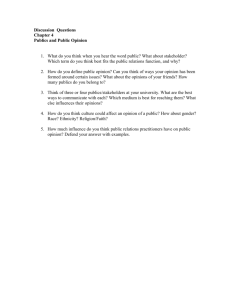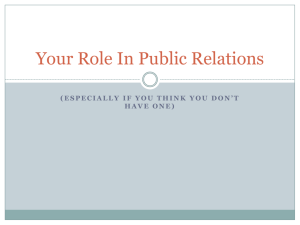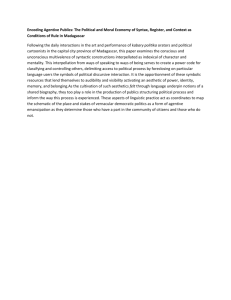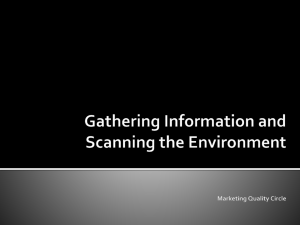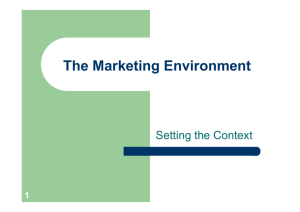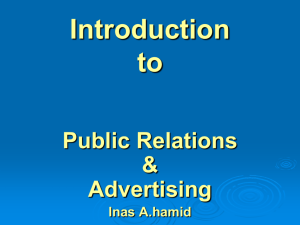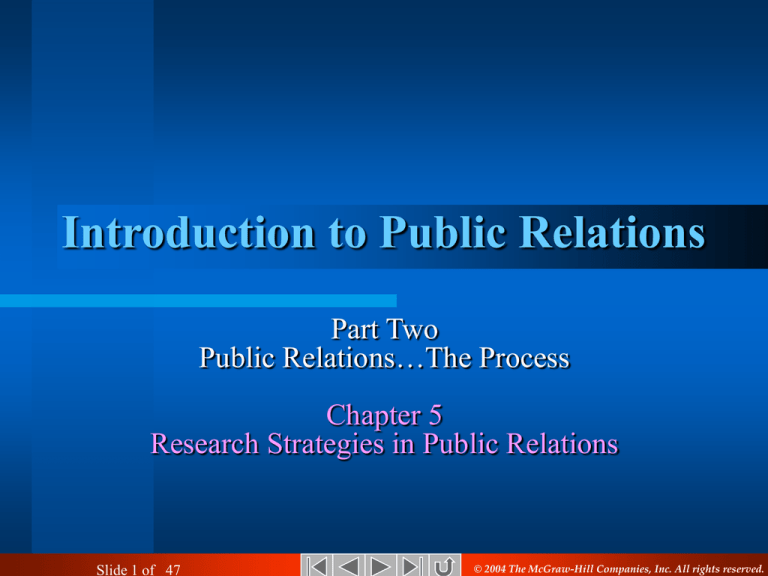
Introduction to Public Relations
Part Two
Public Relations…The Process
Chapter 5
Research Strategies in Public Relations
Slide 1 of 47
© 2004 The McGraw-Hill Companies, Inc. All rights reserved.
Introduction to Public Relations
Public Relations Research
An Assignment Reminder…
Before viewing this lesson, please read the
following textbook material:
Public Relations: The Profession and the
Practice, Chapter 5: Research Strategies in
Public Relations
Slide 2 of 47
A Conceptual Schema for Studying Public Relations
Part 1
Part 2
Part 3
Part 4
The Profession
The Process
The Publics
The Practice
Research
Media
Relations
Financial
Introduction
Chapter 5 falls
here.
Strategic
Planning
History
Public
Affairs and
Government
Employee
Relations
Theory
Corporate
Action and
Communication
Law and Ethics
Evaluation
Slide 3 of 47
Not-forProfit
Community
Relations
Consumer
Relations
Emerging
Trends
Introduction to Public Relations
Public Relations Research
In Part Two—Chapter 5, Our Focus
Is Research Strategies
We will study why research is important in public
relations and the techniques used to conduct this
research in order to obtain valid results.
Slide 4 of 47
Introduction to Public Relations
Public Relations Research
Today’s Learning Objectives are…
•
•
Know what types of research techniques are used by
public relations practitioners
Know how to conduct research for public relations
campaigns.
Understand why research is important.
Slide 5 of 47
Introduction to Public Relations
Public Relations Research
What Is Research?
Research in public relations is a cyclical process
through which practitioners:
•
•
•
•
Monitor the environments of organizations and their publics.
Identify and track events and trends that may influence public
relationships.
Measure the productivity of public relations efforts.
Provide data to enhance the program’s efficiency and
effectiveness.
A diagram may help you visualize these four aids…
Slide 6 of 47
Introduction to Public Relations
What Research Can
Do for You
Public Relations Research
Monitor
Environment
Identify & Track
Events
Measure
Productivity
Enhance Efficiency
& Effectiveness
Slide 7 of 47
Introduction to Public Relations
Public Relations Research
The Role of Research
Research enables practitioners to:
•
•
Provide information for issues management.
Identify and define publics involved in specific
problems.
•
Pretest messages and media to ensure that programs
will produce the best possible results.
•
•
Evaluate the results of programs and campaigns.
Design and execute follow-up activities.
Slide 8 of 47
Introduction to Public Relations
Public Relations Research
Identifying and Defining Publics
Practitioners define
publics by several
aspects.
Age
Gender
Ethnicity
Attitude
Opinion
Behavior *
Political &
religious
affiliation
Media use
* In relation to specific
products, services, or
organizations
Slide
Slide99of
of 47
47
Marital-family
status
Education
Income level
Work location
Residence
Introduction to Public Relations
Public Relations Research
Public Opinion in Public Relations
•
Public relations deals with public opinion rather
than mass opinion; with the opinion of defined,
targeted populations.
•
These publics have been categorized by John
Dewey as groups that…
•
face similar indeterminate situations
•
recognize what is indeterminate in their situations
•
organize to do something about the problem
Slide 10 of 47
Introduction to Public Relations
Public Relations Research
Public Opinion in Grunig’s Categories
Public opinion is sorted a little differently
by James Grunig into three groups ...
Latent Publics
Latent publics do not recognize the problem.
Slide 11 of 47
Introduction to Public Relations
Public Relations Research
The Second Grunig Opinion Group
Aware Publics
Aware publics develop from latent publics
after they recognize the problem.
Slide 12 of 47
Introduction to Public Relations
Public Relations Research
The Third Grunig Opinion Group
Active Publics
Active publics develop from aware publics after they
begin to do something about the problem.
Slide 13 of 47
Introduction to Public Relations
Public Relations Research
Tips for Researching Your Publics
•
•
•
•
•
•
Avoid the general public
Define broad categories
Narrow to definable
components
Set priorities
Identify gatekeepers
Examine Overlap
Let’s consider an example…
Slide 14 of 47
Introduction to Public Relations
Public Relations Research
The CIO Example of Defining a Public
•
•
CIO is a magazine for information managers. Click on their
subscription image below and scan the kinds of questions
they ask new subscribers.
What are key facts CIO wants to know about its readers?
Slide 15 of 47
Introduction to Public Relations
Public Relations Research
Pre-testing Messages and Media
Message and media pretests enable practitioners to:
•
•
•
Identify those that generate the greatest responses.
Adjust message content and/or media schedules to
enhance results.
Produce the best possible result with the lowest possible
expenditure.
Slide 16 of 47
Introduction to Public Relations
Public Relations Research
Graphing a PR Campaign's
Media Pre-test
$ per 10
Responses
Response in
10s
Audience in
1000s
Audience in
1000s
$ per 10
Responses
City Herald
Slide
Slide17
17of
of 47
47
www.city.com
Introduction to Public Relations
Public Relations Research
Questions to Begin Research
•
•
•
What preliminary research is
needed?
What informal research will
help?
Which formal research
techniques do you need?
•
•
•
•
Survey
Content analysis
Experimental
Other
Slide 18 of 47
Zooming in on Preliminary research…
Introduction to Public Relations
Public Relations Research
Preliminary Research
We often begin by doing secondary research such as:
• Libraries
• Databases
• Internet
• Electronic Publications
• Government Documents and websites
• Professional Organizations
Slide 19 of 47
Introduction to Public Relations
Public Relations Research
Libraries
1. Academic journals
2. Government documents
3. Directories and reference works
4. Professional and trade publications
5. Newspapers and periodicals
Slide 20 of 47
Introduction to Public Relations
Public Relations Research
Databases
•
•
•
Academic Universe [consisting primarily of
periodicals]
Dialog [a gateway to hundreds of databases –
the industry’s largest]
ERIC [a repository for academic research]
Slide 21 of 47
Introduction to Public Relations
Public Relations Research
The Internet and World Wide Web
Provide Access To …
•
•
•
•
•
Search engines
Online publishers
Governmental agency databases
Professional and business web sites
Corporate web sites
Slide 22 of 47
Introduction to Public Relations
Public Relations Research
Search Engines
•
Several types of search engines are available to
users of the World Wide Web. Click on any
underlined engine:
•
•
•
General Web-based indexes such as Yahoo.
Industry-specific indexes such as ZDNet.
Web-based meta-search engines, such as Jeeves.
Slide 23 of 47
Introduction to Public Relations
Public Relations Research
Online Publishers
Online publishers include …
•
•
Electronic publications by traditional print
media of all kinds (Forbes Magazine).
E-zines (online magazines such as
Internet.Com) and newsletters published
electronically by a many organizations
Caution: content reliability varies!
Slide 24 of 47
Introduction to Public Relations
Public Relations Research
Governmental Agencies
•
Information compiled by governmental agencies at
all levels is accessible via the Internet. Included are
databases from…
•
•
Legislative bodies such as the…
• U.S. Congress
• state legislatures
• both county and municipal lawmaking bodies
Regulatory agencies at all levels:
• Federal Food and Drug Administration
• local zoning boards
Slide 25 of 47
Introduction to Public Relations
Public Relations Research
Professional And Business Organizations
Many organizations maintain Web sites that
may contain …
•
•
•
Survey data dealing with their industries and/or
members.
Archives of their publications and other materials.
Links to other sites or files containing information of
value to practitioners.
Now let’s look at content analysis …
Slide 26 of 47
Introduction to Public Relations
Public Relations Research
Informal Research Techniques
•
•
•
•
•
Analyzing file records or news clippings
Interviewing key contacts (salespeople) or centers of
influence
Organizing committees or study panels
Using focus groups or national polls
Practicing ‘casual monitoring’ through phone calls, e-mail,
letters
Slide 27 of 47
Introduction to Public Relations
Public Relations Research
Using Recorded Information
Personnel
Records
Sales Records
Production
Records
Here are some various types of
organizational records.
You could also include
attendance records.
Sales Records
How many other types of organizational
records can you name?
Slide 28 of 47
Introduction to Public Relations
Public Relations Research
Regulatory and Governmental Records
Every organization operates under Federal,
state, county and municipal regulations.
Regulation generates two types of records:
•
•
Those maintained by
organizations to comply with
regulations.
Those maintained by
governmental and regulatory
bodies.
From Washington…
Most are available for public inspection
under state and Federal ‘sunshine’ laws.
Slide 29 of 47
…to City Hall
Introduction to Public Relations
Public Relations Research
Key Contacts and Centers of Influence
Every community has its leaders. They include:
•
•
•
•
Elected and appointed officials of all governments
Executives and owners of business organizations
Elected leaders of civic, fraternal and community
organizations
Clergymen, educators and leading members of other
disciplines
How many others can you name?
Slide 30 of 47
Introduction to Public Relations
Public Relations Research
Special Committees in Public Relations
Decision makers and opinion leaders can be assembled
regularly or on an ad hoc basis to help organizations:
•
•
•
Slide 31 of 47
Identify issues before they
become problems.
Suggest alternative courses of
action.
Provide objective views of
matters that are difficult for
‘insiders’ to evaluate.
Introduction to Public Relations
Public Relations Research
Focus Groups Are …
•
•
Most commonly used in qualitative
research.
Usually composed of small numbers of
individuals…
•
who share one or more demographic
characteristics
Slide 32 of 47
Introduction to Public Relations
Public Relations Research
Use Open-ended Questions
with Focus Groups
•
•
Interviewed using openended questions to prompt
interaction and gain insight
into their attitudes,
opinions and beliefs.
Usually videotaped so that
researchers can examine
nonverbal as well as verbal
expressions.
Slide 33 of 47
Introduction to Public Relations
Public Relations Research
Casual Monitoring
Public relations practitioners often monitor information
that routinely comes to their attention, including:
•
•
•
Print and electronic news reports, monitored for
quantity and quality of coverage.
Incoming mail, telephone calls, sales reports and other
documents.
Content of business and industry publications, trade
association reports, and the like.
What other information sources
might you monitor?
Slide 34 of 47
Introduction to Public Relations
Public Relations Research
Most Used Research Techniques
Informal research techniques are most often used by
practitioners. The six listed most often in one study:
•
•
•
•
•
•
Literature searches and electronic retrieval
Publicity tracking
Telephone/mail surveys with simple cross-tabs
Focus groups
Communication audits
Secondary analysis studies
Slide 35 of 47
Introduction to Public Relations
Public Relations Research
Formal Research Techniques
•
•
•
Survey Research--this is the
formal tool used 90% of the
time in public relations.
Content Analysis--statistical
sample of content
Experimental--Used some with
control groups.
Each technique offers potentially
different results that vary in
reliability.
Formal research may be conducted at…
Slide 36 of 47
Introduction to Public Relations
Public Relations Research
Survey Research
•
Most survey research
is designed to…
•
Identify and/or
categorize members of
one or more publics.
Slide 37 of 47
Introduction to Public Relations
Public Relations Research
Content Analysis
Content analysis is a process through which
information can be converted into quantitative data.
The process applies equally to:
•
•
•
Printed materials of all kinds
Transcripts of broadcast information
Transcripts of focus group interviews
How does it work?
Slide 38 of 47
Introduction to Public Relations
Public Relations Research
Content Analysis: A Three-Step Process
1. Representative samples are drawn from sets of documents or
other sources
2. Selected items are searched for key words and sorted by such
factors as length, tone and position in the publication
3. Resulting data are analyzed over time or in comparison to
other data sets, e.g., for competing organizations.
Slide 39 of 47
Introduction to Public Relations
Public Relations Research
Experimental Research
Experimental research encompasses…
•
•
Laboratory experiments conducted in controlled
environments to minimize external factors
Field experiments, in which control is sacrificed to
observe reactions to real environments.
Slide 40 of 47
Introduction to Public Relations
Public Relations Research
Experimental Research
Pretests Channels
Experimental research in public
relations usually deals with pretesting communication channels
and their content, as in
brochures and newsletters.
Slide 41 of 47
Introduction to Public Relations
Public Relations Research
Survey vs. Experimental Research
•
•
Survey research in public relations examines the
attitudes and opinions of audience members.
Experimental research in public relations usually deals
with pre-testing communication channels and their
content, as in brochures and newsletters.
Slide 42 of 47
Introduction to Public Relations
Public Relations Research
Populations and Samples
Formal research almost always deals with samples
drawn at random from specified publics. Random
sampling is …
•
•
Based in probability theory
Used to ensure that results can be generalized to the
larger population
Slide 43 of 47
Introduction to Public Relations
Public Relations Research
Five Types of Sampling
•
•
•
•
•
Simple random sampling allows each member of a
population an equal chance to be selected
Systematic sampling uses a list or directory to select a random
sample
Stratified random sampling, in which the population is
divided into two groups and samples are drawn from each
Cluster sampling, in which groups rather than individuals are
selected at random
Quota sampling, in which fixed numbers of individuals are
drawn from sub-groups
Slide 44 of 47
Introduction to Public Relations
Public Relations Research
More Research Terms
Click on the picture to hear some more research terms and explanations.
Slide 45 of 47
Introduction to Public Relations
Public Relations Research
Another Research Option…
•
•
PR practitioners often
outsource for their
research needs.
Marketing Research
Services, Inc. is an
example of a research
contractor.
Slide 46 of 47
Introduction to Public Relations
Public Relations Research
In Summary…
Public Relations Practitioners have many
research techniques available to them to study
their publics and find out the best way to
communicate their messages.
Slide 47 of 47

